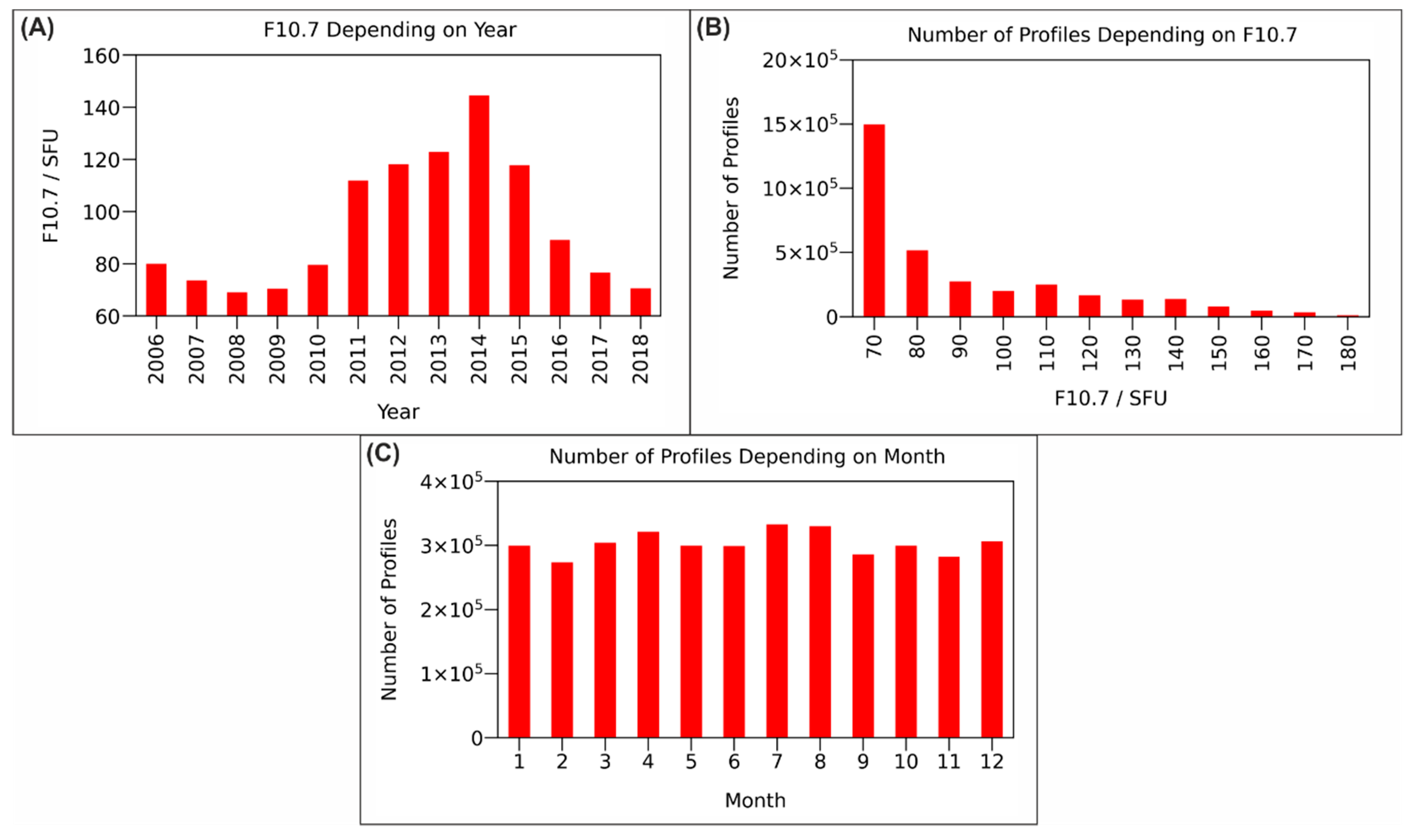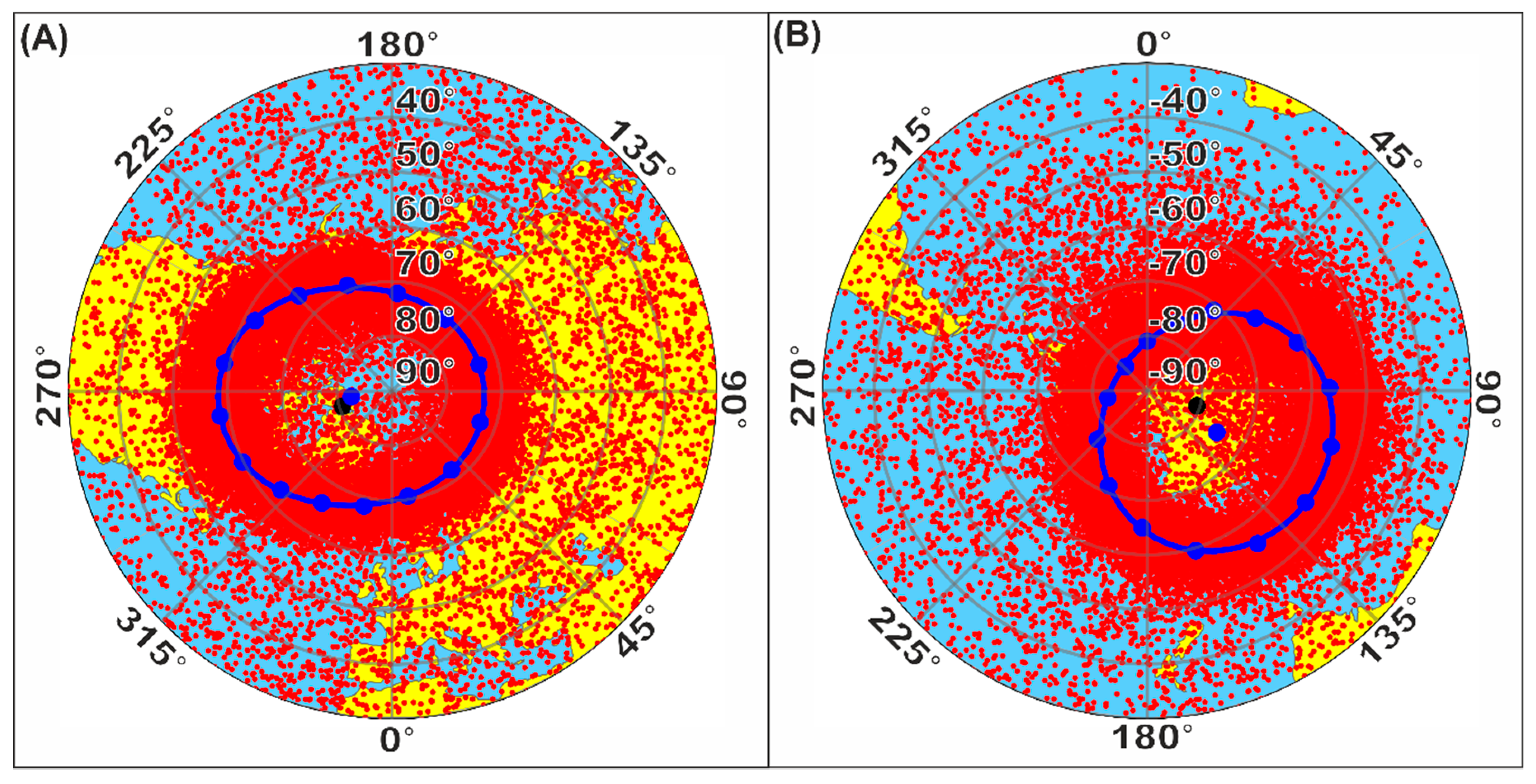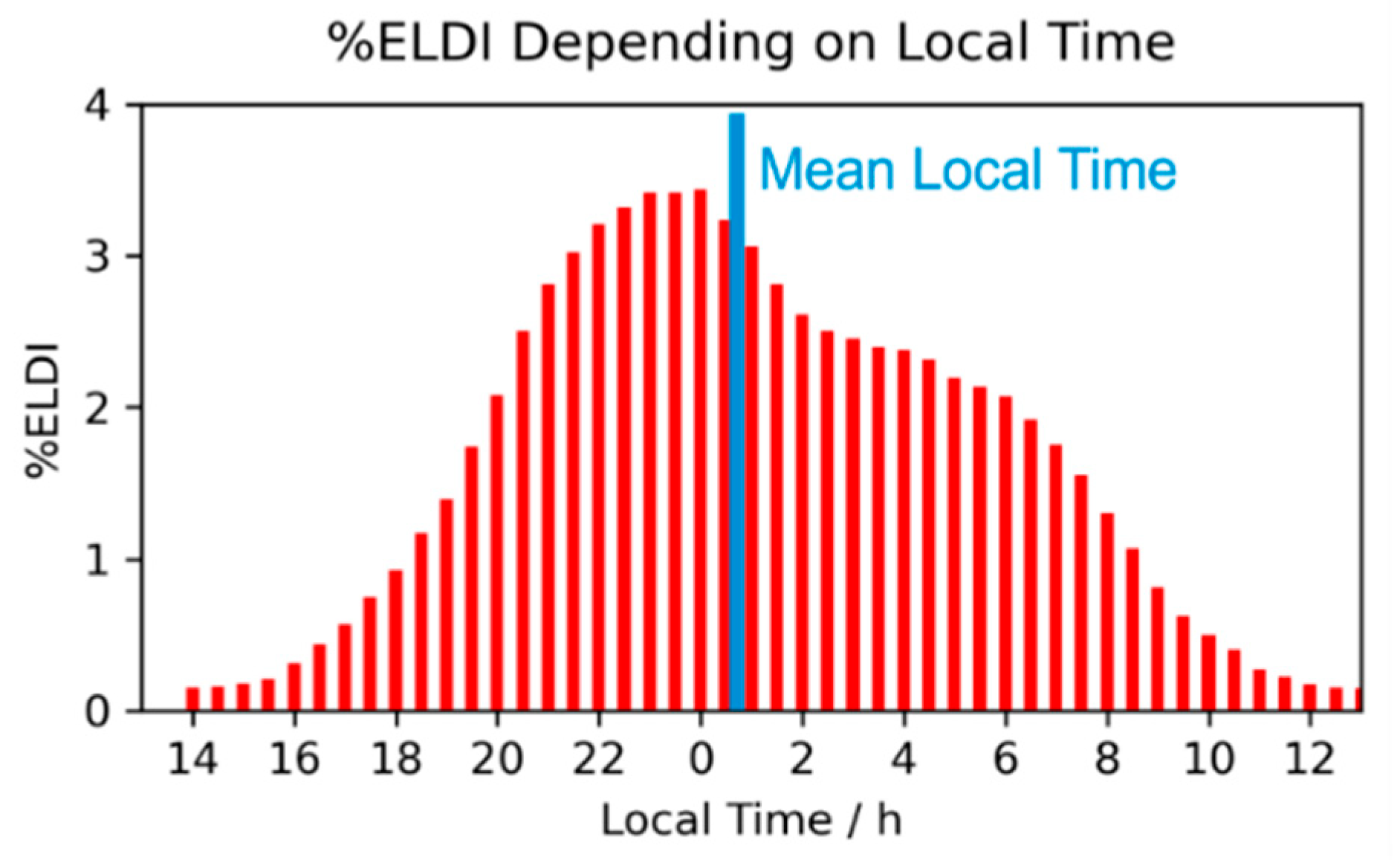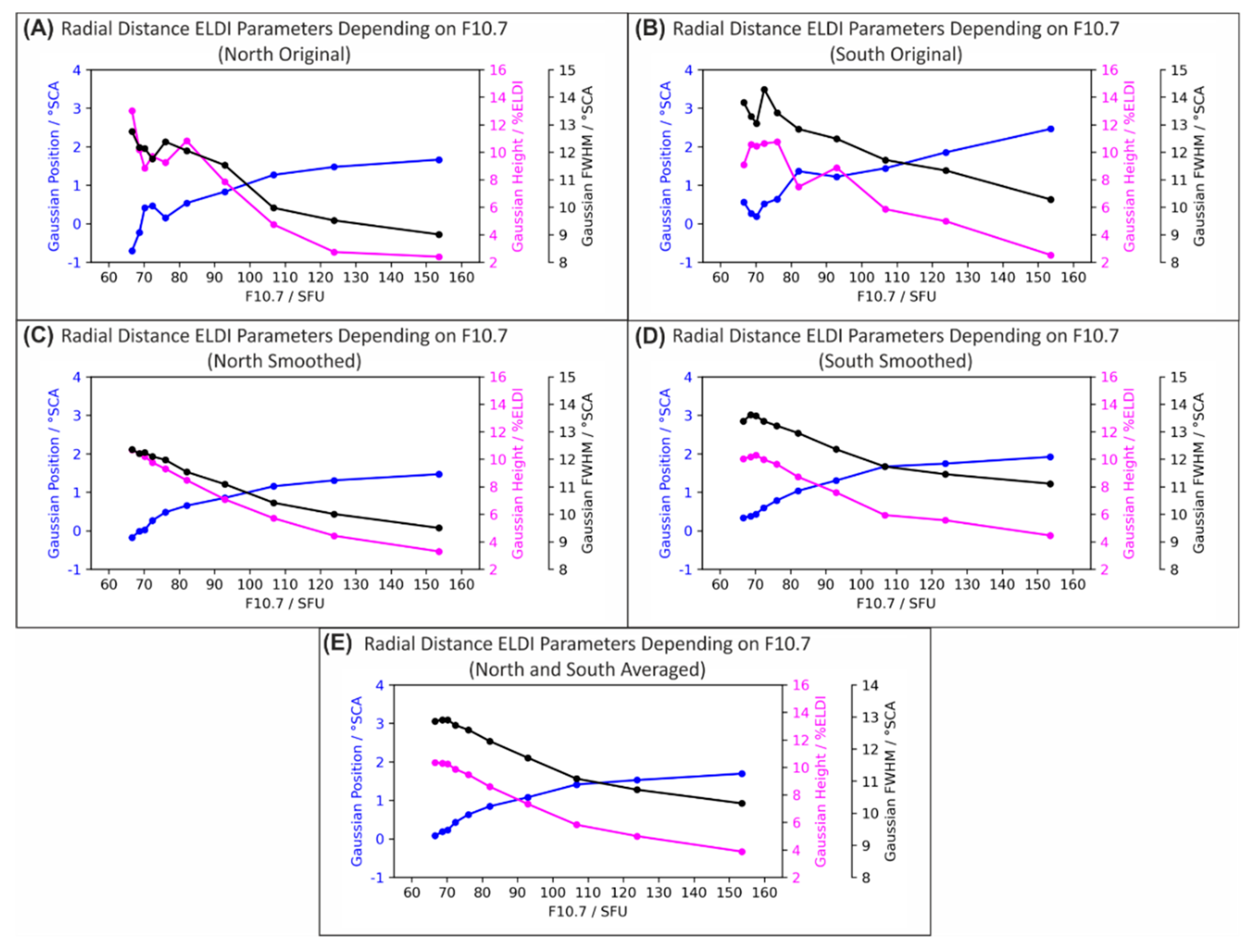E Layer Dominated Ionosphere Occurrences as a Function of Geophysical and Space Weather Conditions
Abstract
1. Introduction
2. Data
2.1. Database
2.2. Data Preparation
2.3. Data Distribution
3. Methods
3.1. Radial Distance ELDI Parameters
3.1.1. Generation of Reference Ellipses for the Northern and Southern Hemispheres
- From the entire set of profiles, we first selected those retrieved during geomagnetic quiet conditions. For this purpose, we used a list containing the timestamps of 27 geomagnetic storms covering the period from 2001 to 2016 as a basis. The storms included in this list are characterized by the Dst index falling below −80 nT. We centered an 11-day-wide window on each storm and then selected all profiles whose timestamps fell outside of these windows.
- Next, we created a circle with a radius of 50 °SCA around the geomagnetic pole as center, assuming that it fully covers the auroral region, and divided it into 15 sectors (see Figure 3).
- For every sector we then computed a separate %ELDI histogram depending on the radial distances of the corresponding profiles from the geomagnetic pole. We did this by dividing the sector into 25 bins with a width of 2 °SCA each and subsequently relating in every bin the number of contained ELDI events to the number of profiles.
- To each histogram we then fit a Gaussian function and afterwards estimated the radial distance of its maximum relative to the geomagnetic pole.
- For every sector we subsequently converted this radial distance and the azimuth angle of the sector relative to the geomagnetic pole into a geocentric latitude/longitude contour point of the ellipse. This gave us 15 contour points for all sectors together.
- Finally, we fit an ellipse to the contour points, simultaneously estimating its focal points and and its semimajor axis by means of least squares fitting. During this process, the following cost function , as defined by Mayer and Jakowski [1] in a similar form, was minimized:where: vector from Earth center to ith contour point/km: vector from Earth center to first focal point/km: vector from Earth center to second focal point/km: length of semimajor axis/°SCA.
3.1.2. Generation of Radial Distance ELDI Parameters
- From their geographic latitude/longitude locations we first computed for all profiles their signed radial distance to the corresponding reference ellipse. In this context, a negative sign denotes profiles located poleward, whereas a positive sign denotes profiles located equatorward of the ellipse.
- Next, we created a %ELDI histogram depending on these radial distances. The histogram covered a distance ranging from −20 °SCA to +20 °SCA and consisted of 40 bins with a width of 1 °SCA each.
- We subsequently smoothed the histogram by means of a running average using a 10-bin-wide window. After smoothing, the histogram showed basically a Gaussian shape for any geophysical condition.
- The histogram was still overlaid by background noise caused by profiles that were misclassified as ELDI events, such as sporadic E events. In contrast to the ELDI, these events are characterized by thin, small patches of high ionization in the E layer [18,19]. The fewer real ELDI events occur, as is the case in local summer, the more they are masked by the noise in the histogram. In order to mitigate the influence of the noise and to uncover the Gaussian shape of the histogram for the subsequent fitting step, we first subtracted a fixed noise value of 1% from each histogram bin. In this respect, we manually estimated the noise value from visual inspection of many histograms. Then, starting from the bin containing the largest %ELDI value, we searched for the first empty bin in the direction of decreasing and increasing radial distances. Next, we set all bins outside of these two empty bins to zero.
- After that we fit the histogram with a Gaussian function by means of least squares fitting, simultaneously estimating the values of its parameters , and . Here we used the following equation for the Gaussian:where: value of the ith histogram bin/%ELDI: radial distance of the ith histogram bin/°SCA: Gaussian height/%ELDI: Gaussian position/°SCA: Gaussian variance/°SCA.
3.2. Local Time ELDI Parameter
- First, we computed a %ELDI histogram depending on the local time of the profiles. In this context, we divided the range of local times into 48 bins, each one being 0.5 h wide.
- As with the radial distance %ELDI histograms, we also smoothed the local time %ELDI histogram by means of a running average using a 10-bin-wide window.
- We found that for many geophysical conditions the corresponding local time %ELDI histogram was skewed or showed several local maxima. This effect may be explained by different precipitation mechanisms that manifest themselves in different types of auroras at different local times, such as discrete or diffuse auroras [20,21,22]. Due to its asymmetry, the approximation of the histogram by a Gaussian function was not justified. Instead, we determined the local time ELDI parameter , which is the mean local time weighted by %ELDI, as a representative for the entire histogram. Since local times repeat cyclically, for each histogram bin we first converted its local time into an angle and then into a unit vector, whose two components we then weighted by the %ELDI value of the bin (Equation (7a)). Subsequently, we separately summed up the resulting vector components and for all bins to get the components and (Equation (7b)). Finally, we converted both components into the mean local time using the atan2 function (Equation (7c)).
3.3. ELDI Parameter Trends
- To generate the ELDI parameter trends depending on a regarded geophysical quantity (as opposed to seasonal dependency), we first established a cumulative histogram of the number of profiles as a function of that quantity. Based on this histogram, we then divided the value range of the quantity into 10 intervals of variable size in such a way that each one contained approximately the same number of profiles.
- As abscissa values of the trends, we subsequently determined for each interval its median value, which divides the interval into two parts, each part containing approximately the same number of profiles.
- Every interval corresponds to a subset of the profiles, which is in turn associated with a certain distribution of ELDI events. For this distribution we computed the four ELDI parameters (Gaussian position, height and FWHM and mean local time) as introduced in the previous sections. These values give the ordinate values of the trends (Figure 7A,B).
- To eliminate outliers and obtain clear trends, we smoothed the original trends by means of a running average using a window width of 5 data points (Figure 7C,D).
- The trends of the individual ELDI parameters depending on any geophysical quantity (as opposed to seasonal dependency) turned out to be similar for the northern and southern hemispheres. Therefore, in this case, we finally computed the average of corresponding trends derived separately for the northern and southern hemispheres (Figure 7E).
4. Results and Discussion
4.1. Dependency on the Season
4.2. Dependency on Solar Activity
4.3. Dependency on Geomagnetic Activity
4.4. Dependency on the Interplanetary Magnetic Field
4.5. Dependency on the Convection Electric Field
4.6. Dependency on Solar Wind Energy
5. Summary and Conclusions
Author Contributions
Funding
Acknowledgments
Conflicts of Interest
References
- Mayer, C.; Jakowski, N. Enhanced E-layer ionization in the auroral zones observed by radio occultation measurements onboard CHAMP and Formosat-3/COSMIC. Ann. Geophys. 2009, 27, 1207–1212. [Google Scholar] [CrossRef]
- Reigber, C.; Lühr, H.; Schwintzer, P.; Wickert, J. Earth Observation with CHAMP: Results from Three Years in Orbit; Springer: Berlin, Germany, 2005; ISBN 978-3-540-26800-0. [Google Scholar]
- Cai, H.; Li, F.; Shen, G.; Zhan, W.; Zhou, K.; McCrea, I.W.; Ma, S. E layer dominated ionosphere observed by EISCAT/ESR radars during solar minimum. Ann. Geophys. 2014, 32, 1223–1231. [Google Scholar] [CrossRef]
- Mannucci, A.J.; Tsurutani, B.T.; Verkhoglyadova, O.; Komjathy, A.; Pi, X. Use of radio occultation to probe the high-latitude ionosphere. Atmos. Meas. Tech. 2015, 8, 2789–2800. [Google Scholar] [CrossRef]
- Kamal, S.; Jakowski, N.; Hoque, M.M.; Wickert, J. Evaluation of E Layer Dominated Ionosphere Events Using COSMIC/FORMOSAT-3 and CHAMP Ionospheric Radio Occultation Data. Remote Sens. 2020, 12, 333. [Google Scholar] [CrossRef]
- Feldstein, Y.I.; Starkov, G.V. Dynamics of auroral belt and polar geomagnetic disturbances. Planet. Space Sci. 1967, 15, 209–229. [Google Scholar] [CrossRef]
- Holzworth, R.H.; Meng, C.-I. Mathematical representation of the auroral oval. Geophys. Res. Lett. 1975, 2, 377–380. [Google Scholar] [CrossRef]
- Carbary, J.F. A Kp-based model of auroral boundaries. Space Weather 2005, 3. [Google Scholar] [CrossRef]
- Xiong, C.; Lühr, H. An empirical model of the auroral oval derived from CHAMP field-aligned current signatures—Part 2. Ann. Geophys. 2014, 32, 623–631. [Google Scholar] [CrossRef]
- Newell, P.T.; Sotirelis, T.; Liou, K.; Meng, C.-I.; Rich, F.J. A nearly universal solar wind-magnetosphere coupling function inferred from 10 magnetospheric state variables. J. Geophys. Res. 2007, 112. [Google Scholar] [CrossRef]
- Anthes, R.A.; Bernhardt, P.A.; Chen, Y.; Cucurull, L.; Dymond, K.F.; Ector, D.; Healy, S.B.; Ho, S.-P.; Hunt, D.C.; Kuo, Y.-H.; et al. The COSMIC/FORMOSAT-3 mission: Early results. Bull. Am. Meteorol. Soc. 2008, 89, 313–333. [Google Scholar] [CrossRef]
- Rocken, C.; Kuo, Y.-H.; Schreiner, W.S.; Hunt, D.; Sokolovskiy, S.; McCormick, C. COSMIC system description. Terr. Atmos. Ocean. Sci. 2000, 11, 21–52. [Google Scholar] [CrossRef]
- Liou, Y.-A.; Pavelyev, A.G.; Liu, S.-F.; Pavelyev, A.A.; Yen, N.; Huang, C.-Y.; Fong, C.-J. FORMOSAT-3/COSMIC GPS Radio Occultation Mission: Preliminary Results. IEEE Trans. Geosci. Remote Sens. 2007, 45, 3813–3826. [Google Scholar] [CrossRef]
- CDAAC. COSMIC Data Analysis and Archive Center. Available online: https://cdaac-www.cosmic.ucar.edu/ (accessed on 15 December 2020).
- SPDF. OMNIWeb Service. Available online: https://omniweb.gsfc.nasa.gov/ (accessed on 15 December 2020).
- Kelley, M.C. The Earth's Ionosphere: Plasma Physics and Electrodynamics, 2nd ed.; Academic Press: Cambridge, MA, USA, 2009; Volume 96, ISBN 978-0120884254. [Google Scholar]
- WDC. Magnetic North, Geomagnetic and Magnetic Poles. Available online: http://wdc.kugi.kyoto-u.ac.jp/poles/polesexp.html (accessed on 15 December 2020).
- Arras, C.; Wickert, J. Estimation of ionospheric sporadic E intensities from GPS radio occultation. J. Atmos. Sol.-Terr. Phys. 2018, 171, 60–63. [Google Scholar] [CrossRef]
- Wu, D.L.; Ao, C.O.; Hajj, G.A.; de la Torre Juarez, M.; Mannucci, A.J. Sporadic E morphology from GPS-CHAMP radio occultation. J. Geophys. Res. 2005, 110. [Google Scholar] [CrossRef]
- Akasofu, S.I. Recent progress in studies of DMSP auroral photographs. Space Sci. Rev. 1976, 19, 169–215. [Google Scholar] [CrossRef]
- Lui, A.T.Y.; Perreault, P.; Akasofu, S.-I.; Anger, C.D. The diffuse aurora. Planet. Space Sci. 1973, 21, 857–861. [Google Scholar] [CrossRef]
- Lui, A.T.Y.; Anger, C.D. A uniform belt of diffuse auroral emission seen by the ISIS-2 scanning photometer. Planet. Space Sci. 1973, 21, 799–809. [Google Scholar] [CrossRef]
- Doherty, P.H.; Klobuchar, J.A.; Kunches, J.M. Eye on the Ionosphere: The Correlation between Solar 10.7 cm Radio Flux and Ionospheric Range Delay. GPS Solut. 2000, 3, 75–79. [Google Scholar] [CrossRef]
- Sugiura, M. Hourly values of equatorial Dst for the IGY. In Annals of the International Geophysical Year; Pergamon Press: Oxford, UK, 1964; Volume 35, pp. 7–45. [Google Scholar]
- Davis, T.N.; Sugiura, M. Auroral electrojet activity index AE and its universal time variations. J. Geophys. Res. 1966, 71, 785–801. [Google Scholar] [CrossRef]
- Milan, S.E.; Hutchinson, J.; Boakes, P.D.; Hubert, B. Influences on the radius of the auroral oval. Ann. Geophys. 2009, 27, 2913–2924. [Google Scholar] [CrossRef]
- Yokoyama, N.; Kamide, Y.; Miyaoka, H. The size of the auroral belt during magnetic storms. Ann. Geophys. 1998, 16, 566–573. [Google Scholar] [CrossRef]
- Gonzalez, W.D.; Joselyn, J.A.; Kamide, Y.; Kroehl, H.W.; Rostoker, G.; Tsurutani, B.T.; Vasyliunas, V.M. What is a geomagnetic storm? J. Geophys. Res. 1994, 99, 5771–5792. [Google Scholar] [CrossRef]
- Gonzalez, W.D.; Tsurutani, B.T.; Clúa de Gonzalez, A.L. Interplanetary origin of geomagnetic storms. Space Sci. Rev. 1999, 88, 529–562. [Google Scholar] [CrossRef]
- Dungey, J.W. Interplanetary Magnetic Field and the Auroral Zones. Phys. Rev. Lett. 1961, 6, 47–48. [Google Scholar] [CrossRef]
- Baumjohann, W.; Blanc, M.; Fedorov, A.; Glassmeier, K.-H. Current Systems in Planetary Magnetospheres and Ionospheres. Space Sci. Rev. 2010, 152, 99–134. [Google Scholar] [CrossRef]
- Milan, S.E.; Clausen, L.B.N.; Coxon, J.C.; Carter, J.A.; Walach, M.-T.; Laundal, K.; Østgaard, N.; Tenfjord, P.; Reistad, J.; Snekvik, K.; et al. Overview of Solar Wind–Magnetosphere–Ionosphere–Atmosphere Coupling and the Generation of Magnetospheric Currents. Space Sci. Rev. 2017, 206, 547–573. [Google Scholar] [CrossRef]














Publisher’s Note: MDPI stays neutral with regard to jurisdictional claims in published maps and institutional affiliations. |
© 2020 by the authors. Licensee MDPI, Basel, Switzerland. This article is an open access article distributed under the terms and conditions of the Creative Commons Attribution (CC BY) license (http://creativecommons.org/licenses/by/4.0/).
Share and Cite
Kamal, S.; Jakowski, N.; Hoque, M.M.; Wickert, J. E Layer Dominated Ionosphere Occurrences as a Function of Geophysical and Space Weather Conditions. Remote Sens. 2020, 12, 4109. https://doi.org/10.3390/rs12244109
Kamal S, Jakowski N, Hoque MM, Wickert J. E Layer Dominated Ionosphere Occurrences as a Function of Geophysical and Space Weather Conditions. Remote Sensing. 2020; 12(24):4109. https://doi.org/10.3390/rs12244109
Chicago/Turabian StyleKamal, Sumon, Norbert Jakowski, Mohammed M. Hoque, and Jens Wickert. 2020. "E Layer Dominated Ionosphere Occurrences as a Function of Geophysical and Space Weather Conditions" Remote Sensing 12, no. 24: 4109. https://doi.org/10.3390/rs12244109
APA StyleKamal, S., Jakowski, N., Hoque, M. M., & Wickert, J. (2020). E Layer Dominated Ionosphere Occurrences as a Function of Geophysical and Space Weather Conditions. Remote Sensing, 12(24), 4109. https://doi.org/10.3390/rs12244109





